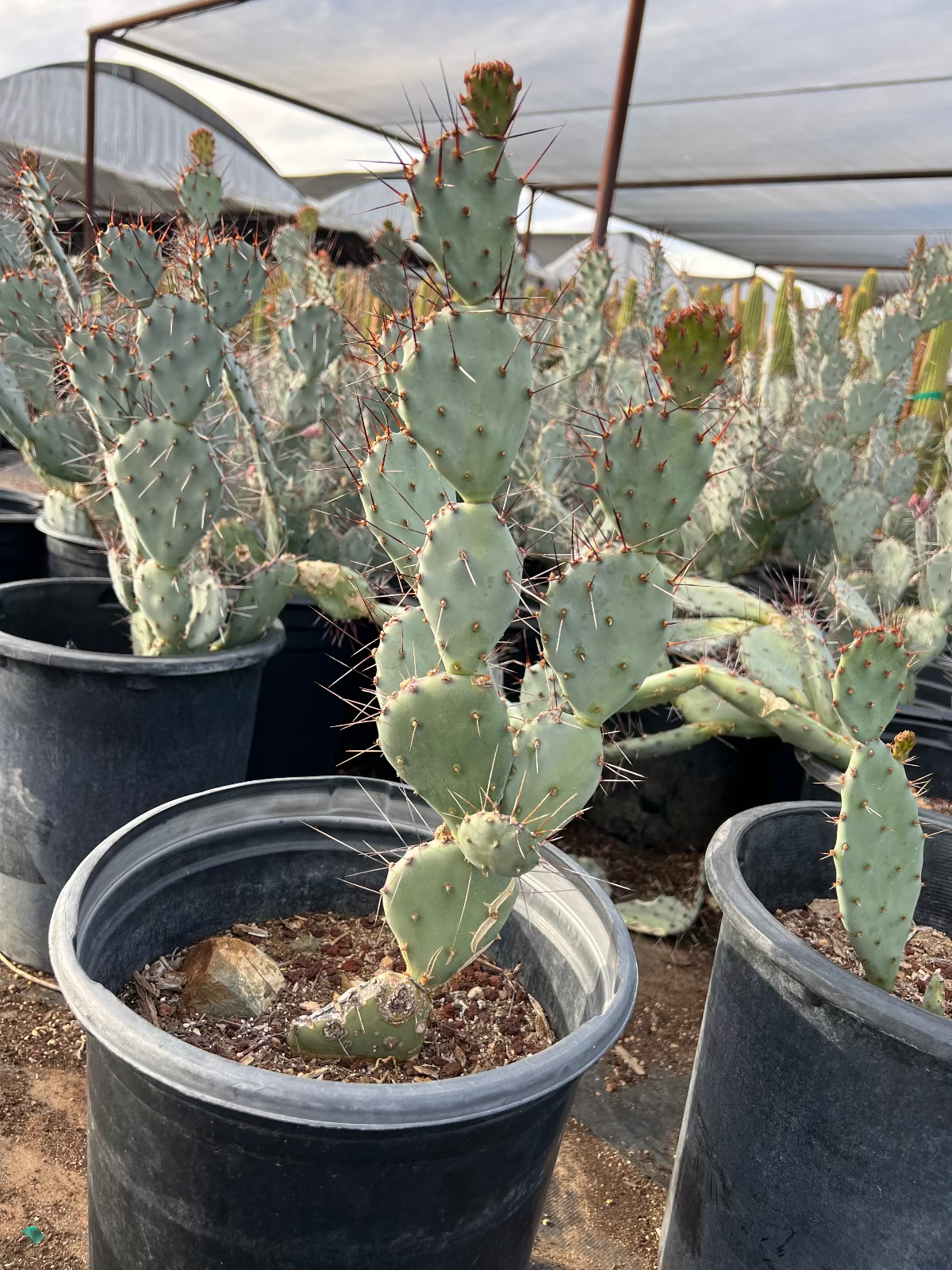My Store
Baby Rita
Baby Rita
Couldn't load pickup availability
Plant Type: perennial, dwarf shrubby prickly pear cactus**
Plant Height: 1–2 feet (can reach 2.5 feet in maturity)**
Spread: 2–4 feet
Flower Color: bright yellow with orange centers
Sun Exposure: Full sun
Baby Rita / Opuntia violacea ‘Baby Rita’: A Compact Purple Jewel for the Desert Landscape
Opuntia violacea ‘Baby Rita’, commonly called the Baby Rita Prickly Pear, is a compact and colorful dwarf form of the classic Santa Rita Prickly Pear (Opuntia violacea). This variety is prized for its brilliant purple pads, vivid yellow-orange flowers, and manageable size, making it one of the most decorative and versatile prickly pears for Arizona landscapes. Despite its small stature, Baby Rita delivers year-round color and form while requiring virtually no maintenance—thriving in heat, drought, and poor soils.
Key Features of Opuntia violacea ‘Baby Rita’
The Baby Rita forms neat, mounding clusters of flattened, round pads that are blue-green to lavender-purple, intensifying in color during cold weather or drought stress. Its compact habit and rounded pads give it a tidy, symmetrical appearance that works beautifully in both modern and natural desert designs.
In spring through early summer, the plant bursts into large golden-yellow blooms with orange centers, which contrast dramatically with the purple pads. These cheerful flowers are followed by deep red fruits, adding an additional layer of seasonal interest.
Unlike larger Opuntias, Baby Rita stays low and manageable, making it perfect for small gardens, courtyards, and container plantings. Its vivid hues change with the seasons—brighter lavender in winter and more blue-green in summer—bringing subtle movement and vibrancy to the landscape.
Growing and Care Tips
Opuntia violacea ‘Baby Rita’ thrives in full sun and fast-draining soil, making it perfectly adapted to Arizona’s desert conditions. It prefers to be planted in open, sunny areas and handles reflected heat from walls, rock, or pavement with ease.
During establishment, water deeply every 14–21 days depending on temperature and soil drainage. Once established, water only every 4–6 weeks in summer and rarely, if ever, in winter. Overwatering can lead to pad rot or discoloration.
This variety is extremely hardy—cold tolerant down to 10°F and heat resistant above 110°F. Pruning is rarely necessary except to remove old or damaged pads. Because glochids (tiny hairlike bristles) are present, use gloves or tongs when handling.
For containers, choose a wide, shallow pot with gritty cactus mix or decomposed granite for excellent drainage and to accentuate the plant’s color and structure.
Landscaping Uses
The Baby Rita Prickly Pear is a colorful and compact accent plant, ideal for rock gardens, borders, or raised planters. It shines as a foreground feature in desert landscapes, bringing soft texture and color contrast among larger succulents or cacti.
Pair it with Blue Glow Agave, Golden Barrel Cactus, or Desert Spoon (Dasylirion wheeleri) for a balanced mix of forms and hues. Its purple pads and golden blooms make it a striking choice for modern xeriscapes, courtyards, or container arrangements.
Because of its small size and lack of long spines, it’s also an excellent option for family-friendly landscapes or entryway gardens, where safety and beauty must coexist.
Summary
The Baby Rita Prickly Pear (Opuntia violacea ‘Baby Rita’) is a miniature desert marvel—bright, hardy, and endlessly charming. With its glowing purple pads, golden-yellow flowers, and compact form, it adds both color and character to any Arizona garden. Equally suited to containers or in-ground landscapes, Baby Rita delivers a sophisticated yet playful desert aesthetic while asking for almost nothing in return.
Three Timbers Installation Guide (Feel Free to Follow):
Opuntia violacea ‘Baby Rita’ Planting Guide:
Location: Full sun; select an open area with at least 8 hours of direct sunlight daily. Handles reflected heat and dry conditions easily.
Soil: Use a sharply draining cactus mix blended with decomposed granite or pumice. Avoid compact or clay-heavy soils.
Spacing: Allow 2–4 feet between plants or nearby structures to accommodate mature spread and airflow.
Planting Depth: Keep pads level with or slightly above soil grade to prevent moisture buildup at the base. Avoid burying pad joints.
Support: None required; pads root and stabilize naturally under warm, dry conditions.
Watering Guide:
Watering After Planting: Water deeply once after installation to settle the soil. Then allow it to dry completely before watering again. During the first 3–4 months, water every 14–21 days depending on temperature and drainage.
When is the Plant Established? Baby Rita is considered established after 6–9 months, once new pads appear and purple coloration deepens during seasonal temperature shifts.
Watering Once Established: Water every 4–6 weeks in summer if no rainfall occurs. In winter, water only during extended drought.
Drip Irrigation Setup: Install one low-flow emitter (0.5–1 gallon per hour) about 8–10 inches from the base, angled outward. Run sparingly and allow soil to dry fully between cycles.
General Watering Tips: Always confirm soil dryness before watering. Overwatering can dull pad color and cause rot. A top dressing of decomposed granite or gravel enhances drainage, stabilizes soil temperature, and highlights the plant’s purple tones. Keep gravel several inches away from the base for airflow and long-term plant health.
Share
















